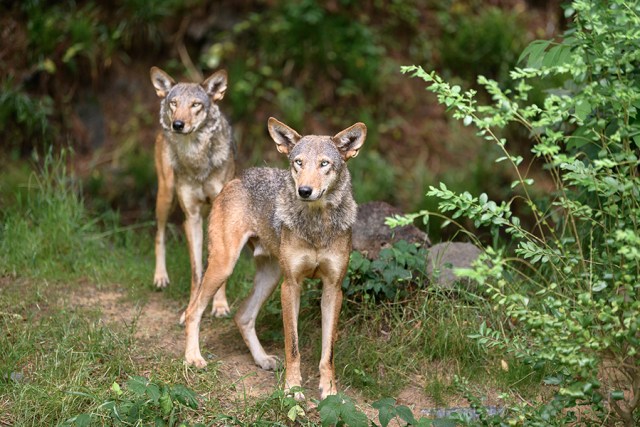Eno and Ellerbe’s next adventure
September 30, 2022
The Museum has housed red wolves since November 1992. I touched my first red wolf in February of 1993 – the first of about 50 red wolves I’ve been fortunate to work with. These two dates are etched in my mind. Working at an institution committed to the recovery of one of the most endangered animals on the planet has been an honor.

But the story isn’t about me. It’s about the commitment, cooperation, and determination of so many people and institutions coming together to reverse the course of what was inevitably a path towards the extinction of red wolves.
The US Fish & Wildlife Service is the leader that pulls together institutions, scientists, government agencies, biologists, and citizens. They challenge us all to heed the call to work together to solve the puzzle of restoring red wolves to the wild.
The Museum’s involvement over the years has been multi-fold. We’ve connected with millions of our visitors and shared the story of the red wolf. Guests, students, and program participants have seen this shy and elusive species up close in our red wolf habitat. By creating connections and developing relationships, I am sure we have positively impacted the survival of this species. As a North Carolina facility, imagine being able to say to guests that one of the most endangered animals on the planet is only roaming free right here, in our state.



The Museum has provided almost 50 red wolves a temporary home since 1992. Red wolves are moved to different facilities (or released to the wild) to ensure the most genetically diverse population. Some years we’ve had the pleasure of housing brothers here, or companion pairs. Other years we’ve had the privilege of having breeding pairs here. With only about 25-30% of breeding pairs successfully producing offspring, having five litters of pups born here has been a gift we should not take for granted.
1993, 2002, 2017, 2018, and 2019 were magical years for those that love the Museum and red wolves. These are years we welcomed newborns to the planet. Pups are what we need to keep the species alive—and as we all know, they are pretty darn cute.

For some, it’s hard to think of these red wolves as just passing through the Museum. For me, I try to think of each wolf as a gift to those fortunate enough to see and meet it. We do all that we can to support the charge of the Fish & Wildlife Service to recover red wolves.
Now that you have a brief overview of our involvement in the red wolf recovery program and how AMAZING it is to have red wolf pups born here. Let’s talk about Eno (M2247) and Ellerbe (M2246), the red wolf brothers, who were born at the Museum about 4.5 years ago. Of all the pups born at the Museum, these two have spent the most time at the Museum.



Like all pups, these two were – and are — beautiful creatures, who have captured many people’s hearts, and innately encouraged many of us humans to do better for our planet and our planet’s creatures. Check out Eno and Ellerbe here, or here, or maybe here, or how about here or all grown up here. Or how about reminiscing while watching these incredible videos of them, here, or here. Perhaps our all-time favorite video belongs to Ellerbe when he took a bite out of the den camera; check it out here.
Why my reflection? Well, it’s time for the boys to move on to their next home. All the red wolves in the recovery program are temporary residents at whatever zoo, museum, nature center, or facility in which they reside. Since April 20, 2018, I knew we would be saying goodbye at some point. Goodbyes, as we know, are part of the job. In fact, we sent the younger siblings — and parents — of Eno and Ellerbe to the Mill Mountain Zoo in January 2020. Moreover, two of their siblings from the 2019 litter moved on from Mill Mountain Zoo and are now at Carolina Tiger Rescue.
The next home for Eno and Ellerbe will be in the eastern part of our state, at the Red Wolf Center. I am sure this home will only be temporary for them as well. In future years, I expect that they will move on and be part of future breeding pairs, hoping to make a new generation of pups that will be part of keeping this species around in our state and on our planet.


